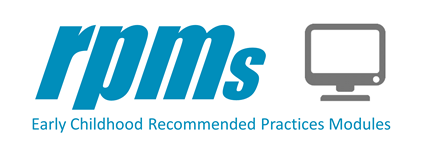Resource Search
Keyword Search
23 results found
Check Your Knowledge questions and feedback for Module 3 Environment, Lesson 1 Ask the Expert
Check Your Knowledge questions and feedback for Module 3 Environment, Lesson 2 Gathering Information
Check Your Knowledge questions and feedback for Module 3 Environment, Lesson 3 Take Action
Drs. Lori Erbrederis Meyer and Tricia Catalino Answer Questions about Early Childhood Environments
A collection of resources that support the DEC Recommended Practices for Environment.
List of DEC Recommended Practices for Environment
Everyday experiences are the building blocks for child learning. The more opportunities a child has to participate actively in everyday classroom activities, the more learning will occur. Children with disabilities sometimes need extra supports in order to participate in these activities. Assistive Technology (AT) may help. AT devices can be low-tech or high-tech. Low-tech support can be something as simple as wrapping textured tape around a pencil to make it easier for a child to grasp. High-tech support can include equipment and items such as an augmentative communication device, a tablet computer, or a power wheelchair.
Active toddlers are busy discovering how their bodies move and do interesting things — clapping hands, stomping feet, rolling a ball down a hill, pushing a riding toy, and more! Be sure there is plenty of space for these experiences both in and out of the classroom.
Presentation handout for Module 3 Environment, Lesson 1 Ask the Expert
Presentation handout for Module 3 Environment, Lesson 2 Gathering Information
Presentation handout for Module 3 Environment, Lesson 3 Take Action
References and Resources for Module 3 - Environment
In this video and see if you can identify the material adaptation that has been made so that the child can eat his lunch independently.
Here is a video example of a teacher using individualized instruction to support a child in the activity of transitioning. Watch how the teacher uses an individual picture schedule to support the child in the activity of transitioning from outdoor play to lining up with her peers. The teacher has created a personal schedule for the child using photos of her participating in the daily activities. This adaptation provides both visual and auditory support in helping the child prepare for and participate in transitioning from outside play time to lining up, to meal time indoors.
Watch the following video and think about ways to adapt or modify physical space so all children may participate fully in the environment. You may want to watch it a few times and make some notes.
This video offers the chance to practice identifying ways to adapt and modify physical space, including examples. On each of the following examples, listen for and review the prompts. You may recognize modifications know, as well as some ideas you hadn't considered.
In this video clip, we observe a child who is blind. His teacher has observed that the child’s level of participation during shared story book reading is low. In response to the low participation, his teacher has decided to create a book that allows the child to touch and move parts of the book.
In this video, try to identify the following: How is the child involved in the activity? How might she be more involved? Can you identify an adaptation that might support her involvement?
In this example, you will see that the mother has provided an adaptation by moving a chair next to the sink so the child is able to reach the sink.
Handout for Module 3 Environment, Voices From the Field - Amanda Arevalo
Handout for Module 3 Environment, Voices From the Field - Andre Miguel
Handout for Module 3 Environment, Voices From the Field - Constance Walker
Handout for Module 3 Environment, Voices From the Field - Ted Bovey
